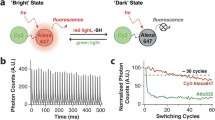Abstract
Super-resolution microscopy, or nanoscopy, enables the visualization of cellular structures inaccessible to conventional light microscopy. RESOLFT nanoscopy is especially suitable for the imaging of living cells. It requires fluorescent proteins (RSFPs) that can be repeatedly switched between a fluorescent and a non-fluorescent state by light. We have analyzed the molecular switching mechanisms and generated a family of RSFPs specifically tailored for live cell RESOLFT nanoscopy.
Similar content being viewed by others
Literatur
Tsien RY (1998) The green fluorescent protein. Annu Rev Biochem 67:509–544
Hell SW (2009) Microscopy and its focal switch. Nat Methods 6:24–32
Andresen M, Wahl MC, Stiel AC et al. (2005) Structure and mechanism of the reversible photoswitch of a fluorescent protein. Proc Natl Acad Sci USA 102:13070–13074
Andresen M, Stiel AC, Trowitzsch S et al. (2007) Structural basis for reversible photoswitching in Dronpa. Proc Natl Acad Sci USA 104:13005–13009
Brakemann T, Stiel AC, Weber G et al. (2011) A reversibly photoswitchable GFP-like protein with fluorescence excitation decoupled from switching. Nat Biotechnol 29:942–947
Grotjohann T, Testa I, Reuss M et al. (2012) rsEGFP2 enables fast RESOLFT nanoscopy of living cells. eLife 1:e00248
Grotjohann T, Testa I, Leutenegger M et al. (2011) Diffraction-unlimited all optical imaging and writing with a photochromic GFP. Nature 478:204–208
Testa I, D’Este E, Urban NT et al. (2015) Dual channel RESOLFT nanoscopy by using fluorescent state kinetics. Nano Lett 15:103–106
Lavoie-Cardinal F, Jensen NA, Westphal V et al. (2014) Two-color RESOLFT nanoscopy with green and red fluorescent photochromic proteins. Chemphyschem 15:655–663
Ratz M, Testa I, Hell SW et al. (2015) CRISPR/Cas9-mediated endogenous protein tagging for RESOLFT super-resolution microscopy of living human cells. Sci Rep 5:9592
Author information
Authors and Affiliations
Corresponding author
Additional information
Martin Andresen 1998–2004 Biologiestudium an der Universität Göttingen, dort 2004–2009 Promotion. Seit 2009 Postdoc am Max-Planck-Institut für bio - physikalische Chemie, Göttingen.
Nickels Jensen 1999–2005 Biologiestudium an den Universitäten Kiel und Bielefeld. 2005–2010 Promotion an der Universität Bielefeld. Seit 2010 Postdoc am Max-Planck-Institut für biophysikalische Chemie, Göttingen.
Stefan Jakobs 1990–1995 Biologiestudium an den Universitäten Kaiserslautern und Manchester, UK. 1995–1999 Promotion am Max-Planck-Institut für Züchtungsforschung, Köln. 2007 Habilitation (Zellbiologie/Botanik) an der Universität Göttingen. Postdocs in Köln und Göttingen in der Abteilung von Prof. Dr. S. W. Hell. Seit 2005 Forschungsgruppenleiter am Max-Planck-Institut für biophysikalische Chemie, Göttingen. Seit 2010 Professor für hochauflösende Mikroskopie an der Universitätsmedizin Göttingen.
Rights and permissions
About this article
Cite this article
Andresen, M., Jensen, N. & Jakobs, S. Reversibel schaltbare fluoreszierende Proteine für die Superauflösung. Biospektrum 22, 365–367 (2016). https://doi.org/10.1007/s12268-016-0699-7
Published:
Issue Date:
DOI: https://doi.org/10.1007/s12268-016-0699-7




